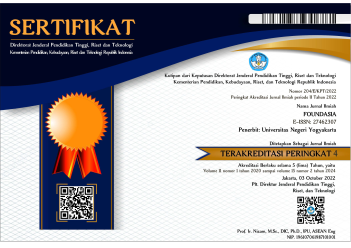Focus and Scope
The results of research and analysis contained in the journal accommodate manuscripts on foundations of education include: philosophy of education, socio-anthropology of education, educational psychology, educational economics, educational history, political education, and comparative education.
Section Policies
Articles
Peer Review Process
Articles sent to FOUNDASIA will be reviewed by reviewers. The decision made for the article was the result of the approval of the Editorial Team based on the suggestions submitted by the reviewer.
Open Access Policy
This journal provides immediate open access to its content on the principle that making research freely available to the public supports a greater global exchange of knowledge.
Publication Ethics
This is the statement of ethics for FOUNDASIA published by Faculty of Department of Philosophy and Sociology of Education, Faculty of Education, Yogyakarta State University in collaboration with the Educational Foundation Study Forum. This statement was adapted from the principles of the Committee on Publication Ethics (COPE) and covers the code of ethics for chief editor, editorial board members, reviewers, and authors.
Authors need to uphold publication ethics if they wish to publish their scientific works in the publication. The publication ethics is as follows:
- Morality: recognize code, system of rules of what is right or wrong in research and publication and to behave accordingly.
- Scientific integrity: uphold the rules, the nature, and the scientific truth worthiness.
- Honesty: conduct research in sincere manner, do not involve in any allegations, frauds, or misconduct; report research results accurately, objectively, promptly and do not contain false or misleading data.
The ethic norms that must hold by the Authors who wish to publish their scientific research on the FOUNDASIA, as follows:
- The authors must uphold the scientific conduct, understanding the risks and benefits of their publication paper.
- The article is free from misconduct behaviour, include: fabrication, falsification, plagiarism or auto-plagiarism.
- The author requires to follow appropriate citation in all statements, ideas, and which are not their original research results.
- The article is relevant to the FOUNDASIA topic areas.
- The article does not produce any conflicts of interest or potential cause with any certain parties.
- The authors that listed in the published articles are truly competent and have significant contribution in the related fields.
- Republishing articles or parts of articles, submitting to one or more journals at the same time or using text or images without permission is not allowed.
Duties of Reviewers
- Must disclose any competing interest before agreeing to review a submission.
- Can refuse to review any submission due to a conflict of interest or inadequate knowledge.
- Review all submissions objectively, fairly, and professionally.
- Reveal any ethical misconduct encountered while reviewing to the Chief Editor for further action.
- Should ensure the originality of a submission and be alert to any plagiarism and redundant publication.
- Must not discuss the content of the submission without permission.
- Adhere to the time allocated for the review process. Requests for extension to review the submission is at the discretion of the Chief Editor.
Duties of Editorial Tim Members
- Actively contribute to the development and the greater good of the journal.
- Act as ambassadors for the journal.
- Continuously support and promote the journal.
- Review any work assigned to them.
Duties of Editors in Chief
- Evaluate manuscripts fairly and solely on their intellectual merit.
- Ensure confidentiality of manuscripts and not disclose any information regarding manuscripts to anyone other than the people involved in the publishing process.
- Has the responsibility to decide when and which articles are to be published.
- Actively seek the views of board members, reviewers, and authors on how to improve/ increase the image and visibility of the journal.
- Give clear instructions to potential contributors on the submission process and what is expected of the authors.
- Ensure appropriate reviewers are selected/ identified for the reviewing process.










